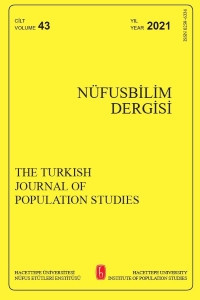TÜRKİYE’DE DOĞURGANLIĞI BELİRLEYEN ARA DEĞİŞKENLER: YAKIN DÖNEME BAKARKEN
Türkiye’de yakın dönemde 1998-2003 arasındaki 5 yıllık dönemde doğurganlık düzeyinde önemli değişimler yaşanmıştır. 1998 yılında toplam doğurganlık hızı 2,7 iken bu rakam 2003 Türkiye Nüfus ve Sağlık Araştırması’nın sonuçlarına göre 2,1’e, yani yenilenme düzeyine kadar düşmüştür. Hatta bölgesel düzeyde bakıldığında beş bölgenin üçünde doğurganlık hızı yenilenme düzeyininde altındadır. Bu çalışmada 1998 ve 2003 yıllarında yaşanan hızlı doğurganlık düşüşünün nedenleri ortaya çıkarılmaya çalışılmaktadır. 1998 ve 2003 yıllarında ölçülmüş olan doğurganlık hızlarını belirleyen faktörler ayrıştırılmaya çalışılırken Bongaarts’ın ara değişkenler modeli kullanılmıştır. Model doğurganlığın gerçekleşebilecek maksimum seviyesi ile gözlemlenen seviyesi arasındaki farkı temel olarak dört ara değişken ile (gebeliği önleyici yöntem kullanımı, evlilik, istemli düşük ve doğum sonrası geçici kısırlık) açıklamaktadır. Çalışmada bir yandan yakın dönemdeki doğurganlık düşüşünün nedenleri araştırılırken bir yandan da Bongaarts modeli ayrıntılı olarak tanıtılmaktadır. Çalışmanın veri kaynağını 1998 ve 2003 Türkiye Nüfus ve Sağlık Araştırmaları oluşturmaktadır. Her iki araştırmada da gebeliği önleyici yöntem kullanımı en etkili ara değişken olarak ön plana çıkmaktadır. Evlenme endeksi ikinci önemli ara değişken durumundadır. İstemli düşük endeksi ve geçici kısırlık endeksininse daha sınırlı bir etkide bulundukları gözlemlenmektedir. Çalışmada doğurganlık düzeyinde yaşanan değişimin bir kısmının 2001 ekonomik krizinin etkilerini taşıyan konjonktürel bir değişim olabileceğinin altı çizilmektedir.
THE PROXIMATE DETERMINANTS OF FERTILITY IN TURKEY: LOOKING AT THE RECENT PERIOD
The fertility of Turkey has declined seriously during 5 years period between 1998 and 2003. While total fertility rate of Turkey was 2.7 in 1998, this value has declined to the replacement level (2.1) according to the results of TDHS-2003. In three of the five demographic regions the total fertility rate is even below the replacement level. In this study it is tried to investigate the causes of this rapid fertility decline that has taken place between 1998 and 2003. While decomposing the factors affecting fertility decline “Proximate Determinants Model” of John Bongaarts are employed. The model explains the difference between maximum, potential level of fertility and observed, actual level of fertility with four proximate determinants, namely contraceptive use, marriage, induced abortion and postpartum infecundability. In the study, on the one hand the causes of fertility decline are investigated, on the other hand proximate determinants model of Bongaats are presented in detail. The data sources of the study comes from 1998 and 2003 Turkey Demographic and Health Surveys (TDHS). The results indicate that the most influential intermediate variable is contraceptive use in both of the surveys. The index of marriage is the second important intermediate variable. It is observed that the impact of induced abortion and postpartum infecundability is limited. In the study it is underlined that changes that occured in fertility level might be due to the postponement of the marriages with the influence of the 2001 economic crisis.
___
- Becker, Gary. (1976) The Economic Approach to Human Behaviour, Chicago.: University of ChicagoPress.
- Blacker, C.P. (1947) “Stages in Population Growth”, The Eugenics Review, Vol. 39.
- Bongaarts, J. (1978) “A framework for analyzing the proximate determinants of fertility”, Population and Development Review, 4 (1): 105-132.
- Bongaarts, J. (1982) “The fertility-inhibiting effects of the intermediate fertlility variables”, Studies in Family Planning, 13 (6/7): 179-189.
- Caldwell, J. (1976) “Toward a restatement of demographic transition theory”. Population and Development Review, 2: 321-366. Caldwell, J. (1982) The Theory of Fertility Decline, New York: Academic Press.
- ISSN: 0259-6334
- Başlangıç: 1979
- Yayıncı: Hacettepe Üniversitesi
Sayıdaki Diğer Makaleler
TÜRKİYE’DE AİLE PLANLAMASINDA KARŞILANMAMIŞ İHTİYACIN ÖLÇÜMÜNE FARKLI BİR YAKLAŞIM
Banu Akadlı ERGÖÇMEN, Alanur Çavlin BOZBEYOĞLU
TÜRKİYE’DE DOĞURGANLIK: KALİTE - MİKTAR YAKLAŞIMI
İSTANBUL’DA BEŞ YAŞ ALTI ÇOCUK ÖLÜMLERİNİN EPİDEMİYOLOJİSİ: 12 YILDA NELER DEĞİŞTİ?
Oğuzhan DOLAR, Gülbin GÖKÇAY, Ayşen BULUT, Olcay NEYZİ
TÜRKİYE’DE DOĞURGANLIĞI BELİRLEYEN ARA DEĞİŞKENLER: YAKIN DÖNEME BAKARKEN
